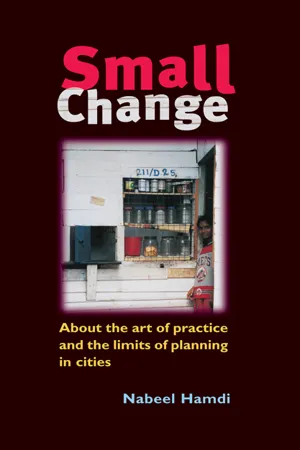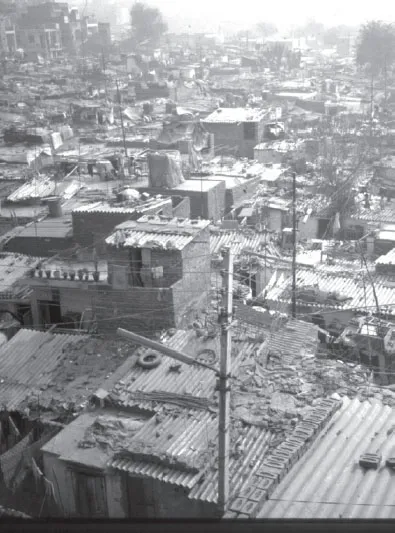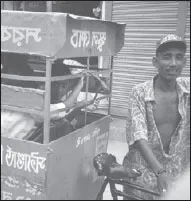No-one remembers what need, command or desire drove Zenobia's founders to give their city this form, as the buildings are constructed on pilings that sit over dry terrain. But what is certain is that if a traveller asks an inhabitant of Zenobia to describe his vision of a happy life, it is always a city like Zenobia that he imagines, with its piling and suspended stairways, a Zenobia perhaps aflutter with banners and ribbons, quite different from the original but always derived by combining elements of that first model.
However, it is pointless to try to decide whether Zenobia is to be classified among happy cities or among the unhappy. It makes no sense to divide cities into these two species, but rather into a different two: those that through the years and the changes continue to give form to their desires and those in which desires either erase the city or are erased by it.’
1
STREET WORK AND DEV-TALK:
WHO CONTROLS THE TRUTH?
In which we get a view from below and another from above; and some idea of what it's like to meddle with the muddle in the middle.
Imagine one of those largely improvised and fast-changing cities that regularly feature in UN ledgers and annual human development reports with alarming statistics on poverty, child mortality, environmental degradation, rates of urbanization and political instability. Its population is growing at some 6 per cent annually – its supply of housing services and utilities has long ceased to match demand through formal channels, public or private. Because of this rampant urbanization, its centre will be choked with traffic and traffic fumes, with pavement dwellers and illegal construction; its periphery will sprawl uncontrollably with formal and informal settlements, markets and business parks. Productivity will be severely constrained by inadequate infrastructure, overly restrictive regulations, unenforceable policies on land reform, tariffs and taxation, and by institutional corruption. Its poor majority will earn less than $2 a day and some less than $1 a day – most of whom will be unable or unwilling to pay for services. Some 30 per cent of its population will lack safe water; one in five will have no access to health care. And because its people are poor, its local government will also be poor, because collecting taxes or tariffs for services will cost more than they could hope to collect. Investment in education, shelter, water and sanitation will be limited without aid, despite the added burden that aid will place on national economics. Therefore, at best, only between 20 per cent and 50 per cent of all solid waste will be effectively disposed of and half its housing stock will be in slum or other informal settlements, most of which are on marginal and unsafe land – on dump sites, railways or canal easements, on landfill, unstable hillsides, under bridges, along fire breaks, on roof tops, in cemeteries, behind chemical factories or on flood plains. Gender and other inequalities – age, disability, ethnicity and class – will be accentuated in the competition for credit, houses, land, jobs, education, health care, transportation, safe water and sanitation.
Walk down any street and quickly you will get a sense of what the issues are, of how all the aid and planning, and non-planning, appears on the ground; of what a development agenda might begin to look like. Spot, for example, the buckets in line at a standpipe that delivers water for two or three hours a day (if you are lucky); observe the uncleared rubbish and blocked drains; the public latrines, unusable because they were broken or because they were locked in case they did get broken; and the pirating of electricity and water. Track down the hosepipes to those who do have water, or the electrical line to those who are connected – middle men selling on water and electricity at prices much higher than those charged by the local utility company. Observe the children operating with difficulty hand pumps at the well, the women walking great distances with water buckets, and ask yourself: who manages water? And then, who designs hand pumps and decides acceptable carrying distances? Look down the narrow alleyways, observe the paper, card and timber scraps, plastic sheeting, cloth and other recycled material used for house building, and ask: what happens when there is a fire? How do children get to school, given that the school bus could never gain access to these narrow streets? In any case, who owns what, who is renting to whom, who does what? Observe all the enterprises – people repairing bicycles, making aluminium sheets from soda cans or shoe soles from old rubber tyres, working as scribes or running coffee houses, and ask: what would help their enterprise along? Do they need credit, and if so, where do they get it from? How do they establish markets? Then observe how, in every nook and cranny, under stairwells, between houses, in every leftover space, people put up small kiosks for selling goods and services, small shelters for mechanics or a single washing machine advertising laundry services. And in the street, every evening, an informal market appears that, by midnight, disappears again.
Then pop into any one of the houses you will pass. Look at the priority that people attach to income rather than comfort. How much of the dwelling will be devoted to home-based enterprise, how and where do people cook, eat and sleep? Talk to the family about the money they receive from family members overseas, about ownership, about belonging, about the value of house as ‘social honour’ and you will hear familiar stories: the lack of credit for business or education; the clinic that's too far and, when you do get there, you have no entitlement to treatment or medicine because you have no legal status, no citizenship; the insecurity because of threat of eviction and, with it, the lack of status and entitlement; how children fear using pit latrines because they are dark, because they are designed for adults and because the children fall into the pit; all the divisions between caste, and between newcomers and long-term residents; between the entrepreneurs and the less skilled; between men and women and, again, ask yourself: what is community? What sense of commitment can there be to any long-term planning? Who will likely work with whom in managing services or utilities, building houses or schools, paving roads, running the school bus? Talk to the man who runs around the market with his basket and trolley delivering flowers and vegetables, who makes some 100 trips a day, walking some 2 kilometres, who lays his trolley horizontally at night in some street corner and uses it as a bed. How much does he make? To whom does he pay rent for the trolley? Who does he sell to? Where are his family? How is the trolley cartel organized and could it become a partner in any future work?
Walk into one of the housing blocks, climb the dark, damp, crumbling stairway, observe the network of hosepipes dangling every which way, running from one floor to another, the tangled wires of electricity. The higher up you climb, the lower your status, the cheaper the rent. Enter one of the apartments: two rooms, with a small kitchen and bathroom attached, occupied by a family of six; a mezzanine roughly built for storage; on the balcony – buckets for storing water, carried up every morning because even when there is mains water, the pressure is too low to find its way to the fifth floor. The father is a parking attendant at a local hotel, the sons work in the fish market – where the buses stop, the hub to the neighbourhood. They pay rent to someone they don't know, but that someone gives them security and has done so for 20 years.
Up on the roof – a settlement in its own right – there are roof-top squatters with houses built from bits of wood, tarpaulin sheets and other scavenged materials. There are shops, a small nursery, public latrines connected to rainwater down pipes – the smell of sewage everywhere. They also pay rent to a woman who looks after their interests, who lives on the roof but seems to be well-connected – a partner maybe.
All this in a country laden with debt and in an international environment dominated by aid conditionality and market protectionism. It is here that all the hardship and squalor can be explained, where the barriers to development can be found. The national government will have been ‘lectured on good governance and principles of participation by countries that have an undemocratic stranglehold on international institutions and who, through the international aid regime, consistently undermine local structures, capacities and accountability’.2 The statistics are startling. It will be a country paying some 40 per cent of its national revenue on debt servicing and repayments and unable, therefore, to meet its commitment to proper health care, education and the rest. It will have been undergoing debt restructuring in order to meet its repayment commitment, to promote economic growth and eradicate poverty. There will have been tax cuts, deregulation of markets, a reduction in the role of government and, where possible, its elimination altogether – privatize where you can. Results everywhere have been harmful: the collapse of the internal purchasing power of economies; the outbreak of famines; bread riots; closing of clinics and schools in favour of private institutions; charging of fees that have reduced attendance at schools; charges on medical and hospital attendance, causing a drop in both; general breakdown in curative and preventative care as a result of lack of medical equipment and supplies, poor working conditions and low pay of medical personnel.3
For every dollar it borrows, the government will be returning some four dollars to donor country banks in reverse aid and paying some 15 per cent above market rates for goods and services because of conditionality tied to aid – a direct subsidy globally to exporters in OECD countries of some $2 billion a year. This flow of capital finances the deficit of countries in the North. According to the New Economics Foundation ‘[T]he US now needs about $4 billion a day to finance its current account deficit. This reversal of flows is one of the main features of the phenomenon of globalization, and explains in part, flows of capital away from developing countries and subsequent impoverishment’:4
Among the big donors, the US has the worst record for spending its aid budget on itself – 70 per cent of its aid is spent on US goods and services. And more than half is spent in middle-income countries in the Middle East. Only $3 billion a year goes to South Asia and sub-Saharan Africa.5
As Julius Nyerere, President of Tanzania, said many years ago, ‘Should we really let our people starve so that we can pay our debt?’6 On top of it all, and despite the claim for free markets, there will be severe restrictions placed on trade through taxes, tariffs and quotas, which will have reduced exports. Clothing, our case country's second largest export, will be taxed by the US at 19 per cent (imports from Japan, France or Germany are charged between 0 per cent and 1 per cent). Raw cocoa beans can be exported to the EU and USA without tax, but if the source country processes these it will be charged more: butter at 10 per cent, cocoa powder at 15 per cent and chocolate at 20 per cent – all in order to protect local markets.7
And then there are subsidies. Rich countries also spend some $1 billion a day on subsidies to farmers that will undercut prices worldwide. In the US, its 25,000 cotton farmers receive more than $3 billion each year in support. The international cotton advisors’ committee estimates that these subsidies lower world prices by about 25 per cent.8
Regionally, the share of world exports will have dropped from 1.2 per cent to 1 per cent. Overall, and despite the claims of growth and prosperity, what we find is ‘a position where resources move from the poor to the rich and pollution moves from the rich to the poor’.9 It was Richard Nixon, after all, who said in 1968 ‘Let us remember that the main purpose of American aid is not to help other nations but to help ourselves’.10
Globally, poor countries, who hold 40 per cent of the world population, will receive 3 per cent of the world's income in trade. Although the volume of exports from Africa increased by 25 per cent in the 1980s, the deterioration in terms of trade has meant that its earnings have fallen by 30 per cent since 1981:11
With the creation of the World Trade Organization (WTO) in the mid-1990s, economic globalization, characterized by ‘free trade’ was hailed by corporate leaders and politicians as a new order that would benefit all nations, producing worldwide economic expansion where wealth would trickle down to all. However, it soon became apparent to increasing numbers of environmentalists and grassroots activists that the new economic rules established by the WTO were manifestly unsustainable and were producing a multitude of interconnected fatal consequences – social disintegration, a breakdown of democracy, more rapid and extensive deterioration of the environment, the spread of new diseases and increasing poverty and alienation.12
Still, despite various international targets, some 1.2 billion people worldwide are without safe drinking water and 2.9 billion lack adequate sanitation. The average income of 54 countries declined in the 1990s. Every day 30,000 children die from preventable disease; 500,000 women a year die in pregnancy or childbirth. In the 1990s, 13 million children were killed by diarrhoea. Human development, measured by the human development index (a combination of income, life expectancy and literacy), fell in 21 countries during the 1990s. One in five adults cannot read and 98 per cent of these are in countries of the developing South – two-thirds of these are women.13
The news, however, is not all bad. The Department for International Development (DfID) claims that many targets set within the millennium development goals to improve quality of life are being met. For example, nine out of ten children now go to primary school (20 years ago it was eight in ten); infant mortality has fallen from ten deaths in every 100 births to six. Six out of every ten people have access to clean water compared with four in ten 20 years ago. Overall, the target to halve the number of the world's poor by the year 2015 is within range – so they say.14
Meanwhile, globally, the environmental outlook is bleak, despite some gains. Every year, an estimated 6 million hectares of land in the world turns to desert – an area equivalent to nearly twice the size of Belgium. ‘At least 15 per cent of the Earth's surface is already degraded by human activity’15 by industry, urbanization, deforestation and overgrazing. Weather-related disasters that affected 147 million people a year, on average, 10 years ago, now affect some 211 billion people a year. Forty per cent of the world is short of fresh water; in 30 years this will rise to 50 per cent. Yet the average person in the UK uses 30 gallons per day compared with an average of 2 gallons used by people in the developing countries of the South; New Yorkers use 68 litres a day, a Kenyan 4 litres a day. Half of the world's rivers are seriously depleted and polluted. About 60 per cent of the 227 biggest rivers are disrupted by dams and other engineering works.16
Worldwide, there will be an average of $56 billion of aid a year pumped into a variety of dev...


